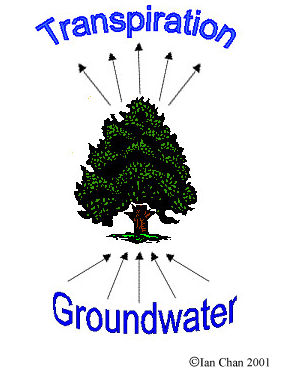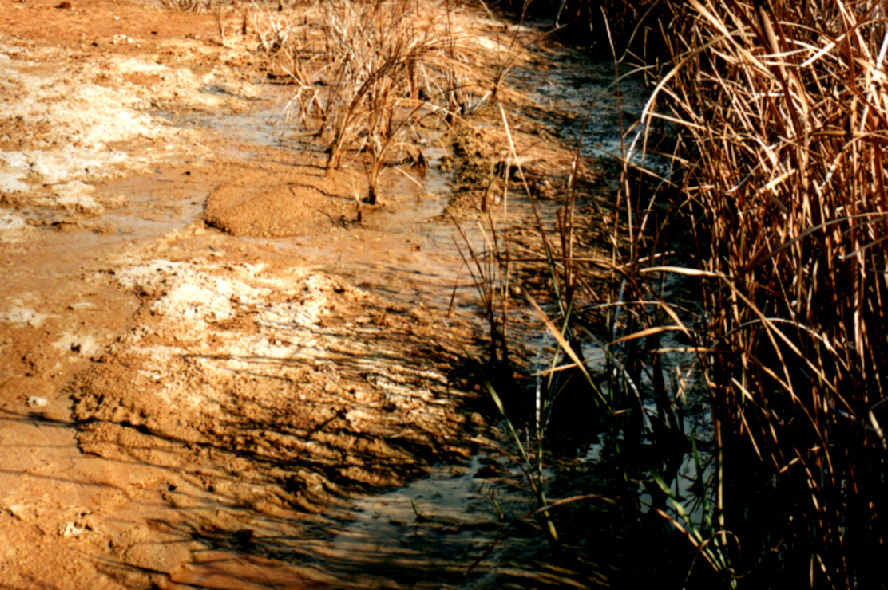SOIL SALINITY


Soil salinity is a major environment problem in Australia caused by both biophysical
human factors. It affects many parts of the country, both rural and urban. Unless
speedy actions are taken by the government, community and individuals,
the problem is going to spread and get worse. The map on the right shows the distribution
of the problem in Australia.
What is Salinity?
There is salt in many parts of the Australian landscape.
Salinity is the presence of salt in the land surface, in soil or rocks,
or dissolved in water in rivers or groundwater.
Salinity can develop naturally,
but where human intervention has disturbed natural ecosystems,
the movement of salt into rivers and onto land has been accelerated.
There are different types of salinity according to their causes, including irrigation,
dryland, and urban.
Causes of Dryland Salinity
Dryland salinity occurs where removal or loss of native vegetation,
and its replacement with crops and pastures that have shallower roots.
This results in more water reaching the groundwater system.
The groundwater rises to near the surface in low-lying areas.
It carries dissolved salts from the soil and bedrock material through which it travels.
As saline groundwater comes close to the soil surface (within 2m),
salt enters the plant root zone.
Even where the groundwater does not bring much salt with it,
the waterlogging of the plant root zone alone can damage or kill vegetation.
 |
Trees are like pumps. They help to discharge water through transpiration. |
Effects of Dryland Salinity
Dryland salinity has many environmental, economic and social impacts. The costs associated with salinity are potentially enormous and are borne not only by the rural community, but also ultimately by the whole country and its environment.
The effects of dryland salinity may impact on:
- Agriculture
- Water quality
- Public infrastructure and urban households
- Biodiversity and the environment
Agricultural impacts
The impacts of dryland salinity on soil have adversely affected agriculture in Australia. The consequences include:
- Significant losses of productivity in agriculture, with some land entirely out of production. With increasing soil salinity, plants always find it more difficult to extract water from the altered soils. Most normal crop and pasture plants are not highly salt-tolerant and will eventually die out under saline conditions.
- Damaged soil structure and increasing content of toxic substances that may be limiting to plant growth.
- More serious soil erosion, both by wind and by water, due to worsening soil structure and reducing vegetation cover.
Impacts on water usage
Dryland salinity may increase salt concentrations in streams and rivers, and has a significant impact
on a wide range of uses, including:
- Declining suitability for drinking by humans and livestock, and for irrigation.
- Increasing costs for water treatment.
- Corroding water pipes, concrete channels, similar infrastructure, and of various machines
and household appliances.
- Affecting industrial and domestic uses such as washing and food processing.
Impacts on public infrastructure, buildings and houses
Dryland salinity also affects rural towns. Apart from land clearing,
salinity there is partly caused by human activities such as over watering of gardens and sports grounds. It has potential effects on infrastructure,
buildings and domestic houses. The impacts include:
- Damage to houses, buildings and other structures caused by the deterioration of brick,
mortar and concrete due to saline water crystallizing in brickwork.
- Corrosion of metal buried in the ground or set in structural concrete may also occur.
- Shifting or sinking of foundations may result in structural cracking,
damage or collapse. Damage to heritage buildings may be of particular concern and land
values may be degraded by salinity.
- Salt damage to roads and highways includes the breakdown of concrete, bitumen and
asphalt with associated pot holing, cracking and crumbling of the road base.
- Damage to underground pipes, cables and other infrastructure due to the breakdown of
unprotected metal, cement and other materials.
- Loss of amenity in recreational areas such as gardens and sports fields due to the
appearance of bare, exposed patches where grass and other plants cannot grow.
- Failure of septic tanks caused by high water tables. This often leads to other
environmental and health problems.
Impacts on biodiversity and the environment
Rising water tables and increasing salinity have serious impacts on native vegetation, in the same way as they do for crops and pastures. Remnant vegetation may be threatened and with this,
a variety of animal species and their habitats.






